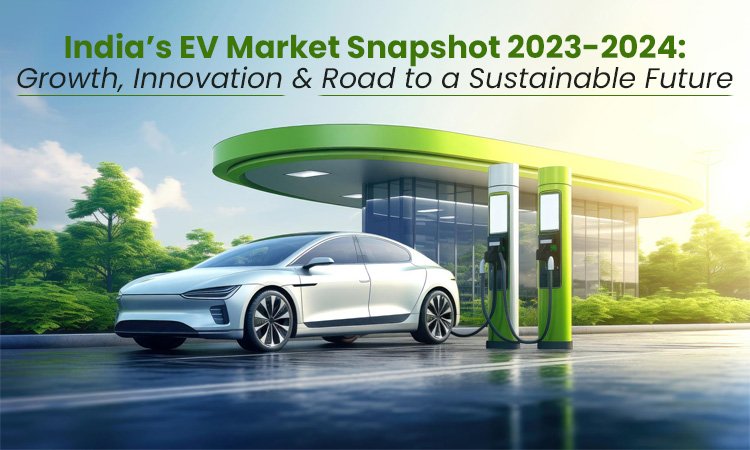
India’s EV Market Snapshot 2023–2024: Growth, Innovation & Road to a Sustainable Future
The Indian electric vehicle (EV) market is undergoing a transformative journey, firmly establishing itself as a significant player in the global transition towards sustainable mobility. As we delve into the period spanning 2023-2024, we find a landscape filled with exhilarating growth statistics, groundbreaking technological advancements, and enhanced global visibility through significant events like the much-anticipated RideAsia EV Expo 2025. The following analysis captures the key highlights that point towards a promising future for the EV industry in India.
A Surge in EV Sales and Market Penetration
The fiscal year 2023–2024 has seen the Indian EV industry achieving groundbreaking milestones, with 30 lakh (3 million) electric vehicles sold, marking a 45% year-on-year increase in sales. This impressive growth has allowed EVs to comprise approximately 6.4% of the overall vehicle market, reflecting heightened consumer confidence and robust governmental and industry support structures that foster such adoption.
The Two-Wheeler Revolution
Leading this transformation is the electric two-wheeler segment, which now makes up an impressive 56% of all two-wheeler sales. The formidable growth in this sector has been catalyzed by the concerted efforts of over 400 startups, all innovating to meet the rising demand for affordable and sustainable personal mobility solutions. This shift not only indicates growing consumer preference but also showcases the entrepreneurial spirit that defines India’s path toward a greener future.
Future of the EV Market: Ambitious Yet Achievable
India’s vision for its EV landscape in the coming years is marked by ambitious yet achievable goals. The trajectory suggests:
- Market growth that could reach ₹20 lakh crore (approximately $2.4 trillion) by 2030.
- The potential to generate 5 crore (50 million) new jobs across various sectors linked to electric mobility.
- A target for EVs and hybrids to achieve an 8% market penetration by 2028.
- Growth in the EV financing sector to around ₹4 lakh crore (~$48 billion).
- Discovery of 6 million tonnes of lithium reserves in Jammu & Kashmir, sufficient to support the production of up to 60 crore EVs.
- Lithium-ion battery lifecycle costs have declined to $115 per kWh, with projections indicating a drop below $100 in the near future.
- The battery recycling market is anticipated to reach a valuation of ₹50,000 crore (around $6 billion) by 2030.
EV Charging Technology: Innovation at Full Throttle
As the number of electric vehicles on the road increases, emphasis on developing EV charging infrastructure has gained momentum. India’s EV charging market is projected to reach ₹70,000 crore (approximately $8 billion) by 2025. Startups such as Clean Electric are leading innovations in this space, unveiling 15-minute universal and interoperable charging solutions that enhance convenience and accessibility for EV users. This progress underscores the critical need for effective charging solutions as EV adoption accelerates.
Spotlight on RideAsia EV Expo 2025
A major highlight in the EV industry calendar is the upcoming RideAsia EV Expo 2025, set to be a transformative event for the sector.
Event Overview
- Over 300 exhibitors showcasing innovations.
- More than 20,000 trade visitors expected.
- Participation from 10+ countries, enhancing international collaboration.
Vehicle Highlights
The expo will feature launches from various segments including two-wheelers, three-wheelers, four-wheelers, e-tractors, and utility vehicles. Notable models expected to be unveiled include:
- Khalsa EV’s L5 model impresses with a powerful range of 203 kilometers on a single charge.
- Citius introduces electric tractors engineered to handle loads ranging from 2 to 5 tons.
Key Focus Areas
The expo aims to address critical areas, including:
- Innovations in battery technology and fast-charging solutions.
- A significant focus on sustainability while striving for carbon footprint reduction.
- In-depth conversations surrounding policy frameworks and investment opportunities within the EV ecosystem.
Conclusion
In summary, India’s EV market presents an electrifying vision of the future, characterized by robust growth, innovation, and strategic planning that promises to reshape the transportation landscape. With a dynamic startup ecosystem, supportive government policies, and an increasingly aware consumer base, India is poised to be a global leader in the electric mobility revolution. The future of transportation is sustainable, and India is firmly in the driver’s seat.



